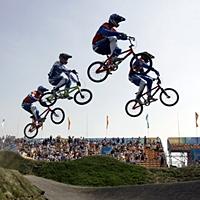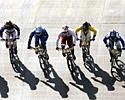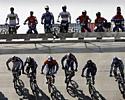
Recently on Cyclingnews.com |
Tales from the start ramp, August 20, 2008
BMX awaits Olympic destiny
By Greg Johnson

|
Bicycle Moto Cross is set to explode onto the Olympic Games this evening, with the high-thrill, frequent-spill cycling discipline landing a prime-time television slot in the United States of America. The broadcast slot not only plays towards the International Olympic Committeeís desire to reach the ĎGeneration Yí market, but also allows BMX World Cup winner Donny Robinson to vie for gold under the watchful eye of his compatriots.
The television coverage in the worldís biggest English speaking market is yet another coup for BMX. Over the past 40 years the sport has grown from a back-yard hobby and is now just hours away from the holy grail - its first Olympiad.
"A lot of people are drawing parallels to the impact that snowboarding has had on the winter games," said USA Cyclingís Andy Lee told KansasCity.com. "It translates to TV very easily. It's exciting. There's a lot of drama. There can be crashes."
Action in the eight-rider, knock-out competition that is BMX racing can be summed up in a word - Kamakazi. Of course, in a display that sums up the BMX punk market, thatís actually one of the competitorís names. The Australian competitor formerly known as Jamie Hildebrandt changed his name to Kamakazi, spelt incorrectly to avoid association with suicide bombers, at the deed poll office some seven years ago. Itís a $280 investment the 27 year-old doesnít regret making.
"What we're doing, it's almost death-defying. If you crash, there's going to be broken bones, there's going to be skin off, there's going to be all sorts of mayhem."-Australia's aptly named Kamakazi explains what we can expect at the Olympics |
"It's nothing like what's in the Games at the moment," Kamakazi told The Age of his sportís Olympic induction. "What we're doing, it's almost death-defying. If you crash, there's going to be broken bones, there's going to be skin off, there's going to be all sorts of mayhem. Anything can - and will - happen on this track."
Kamakazi joins a strong Australian squad at his sportís Olympic debut. In its ranks is BMX World Cup runner up Jared Graves and sixth placed on world standings Luke Madill. Showing his dedication to the sportís Olympic debut, Madill actually built a replica of the Beijing BMX track in his back yard, where the Australian team members have spent some time training.
As the top-ranked nation in the International Cycling Unionís (UCI) Elite Menís standings, USA will be a strong contender in the menís race. Robinson will be joined by North America rankings leader Kyle Bennett and the big name in American BMX Mike Day.
Marc Willers will fly the New Zealand flag after finishing the World Cup in fifth place. He will be joined by Czech Republic rider Michal Prokop and Latvian duo Maris Strombergs and Ivo Lakucs - all of whom have been training at the UCIís replicated Olympic track at the World Cycling Center in Agile, Switzerland.
There will be some legal argy-bargy going on the BMX races, according to the UCIís BMX co-coordinator Johan Lindstrom. "It's actually a contact sport," he said. "We're not going to call any fouls if you use your elbows a little bit on the turns. There could be some violent crashes, for sure, because they go very fast."
Women ready for Beijing battle

|
The womenís event will be equally as fierce as the menís event. The womenís field not only features some highly experienced riders in shoulder-to-shoulder racing, but also some future stars of both the BMX and other cycling disciplines.
One such athlete is a young Briton called Shanaze Reade. As a former BMX World Champion, Reade was already well established in the BMX market when she decided to try track racing in 2007. After a few months training, Reade teamed up with Victoria Pendleton to claim a Track World Championship title in the womenís team sprint.
"I did track cycling to prove that BMX cyclists weren't just people on kids bikes and to show that we are athletes," Reade told AFP. "I think I have done that by setting world records on the track and winning two gold in two years."
Readeís efforts certainly have impressed her peers. Heading into this yearís Olympic Games, Scottish track cycling legend Chris Hoy was full of praise for the 19 year-old. "If I was going to put my mortgage on anyone winning the gold medal, it would be Shanaze," he said.
While Hoy can probably afford to replace the house if she didnít win, following his menís sprint victory last night, itís a massive compliment for the youngster.
Reade will by no means simply walk away with the gold medal. She is faced by strong opponents like reigning World Cup winner Sarah Walker from New Zealand and French strong woman Anne-Caroline Chausson, who finished runner up in this yearís World Cup.
Chausson is one of the oldest competitors to start the event. At 31 years of age, Chausson doesnít fit the BMX stereotype, but as a cycling legend she cannot be discounted in the dash for gold. While Chausson eased off the top level of competition in recent years, after learning of BMXís inclusion in the Olympics she jumped back on the bike and has been training, and winning, on her way to Beijing. In addition to her 15 UCI rainbow world champions jerseys, primarily from downhill mountain biking, Chausson claimed the Alternative Sportsperson of the year title at the 2003 Laureus World Sports Awards.
USAís Jill Kitner, Argentine Gabriela Maria Diaz and Canadaís Samantha Cools will also be strong performers in the womenís race. All three riders claimed top 10 positions in this yearís World Cup, which included a round at the Beijing track.
Track attack

|
While BMX tracks often resemble large dust bowls, the Beijing track is an all-class affair. Organisers have laid down tar on the berms and brought in turf for sections between the courseís long straights. A dash of colour comes from the Olympic themed edges around the course.
Spectators at the facility, which is equipped to hold several thousand fans, will be treated to a thrill from the get-go. Both the menís and womenís tracks start from an elevated ramp which will help riders gather the speed to make the massive first jump.
Catching the footage at the Laoshan course will be a host of television cameras. While there was originally just six cameras permitted on the course, the number has been pushed up to 17, with angles now including a high-speed slow motion camera and a cable-mounted overhead camera which will track the riders as they accelerate down the straight.
